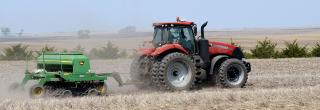
Habitat Management Practices for the Northern Great Plains
(A Farm and Ranch Guide to Developing and Maintaining Wildlife Habitat on the Northern Great Plains) - Section 1
Some management practices benefit all game species, while other practices benefit some species and either have no detectable benefits or are potentially counter-productive to other species.
The table below summarizes habitat management practices and which species benefit, followed by brief descriptions of each management practice.
| Habitat Management Practices for the Northern Great Plains | White-tailed Deer | Mallards | Pheasants | Wild Turkeys |
|---|---|---|---|---|
| Conservation Easements | X | X | X | X |
| Control of Invasive Plants | X | X | X | X |
| Field Borders and Buffer Strips | X | X | X | X |
| Inside-out Haying | X | X | X | X |
| Livestock Management | X | X | X | X |
| Cover Crops | X | X | X | X |
| Planting Food Plots | X | X | X | X |
| Leaving Crops Unharvested | X | X | X | X |
| Reduced Tillage | X | X | X | X |
| Promoting Forbs | X | X | X | X |
| Plant Native Grasses and Forbs | X | X | X | X |
| Plant Shrubs and Trees | X | X | X | |
| Forest Management | X | X | X | |
| Edge Feathering | X | X | ||
| Prescribed Burning | X | X | X | X |
| Mechanical Manipulation | X | X | X | X |
| Water Management and Control Structures | X | X | X | |
| Preventing Depredation Problems | X | X |
Conservation Easements and Partnership Agreements
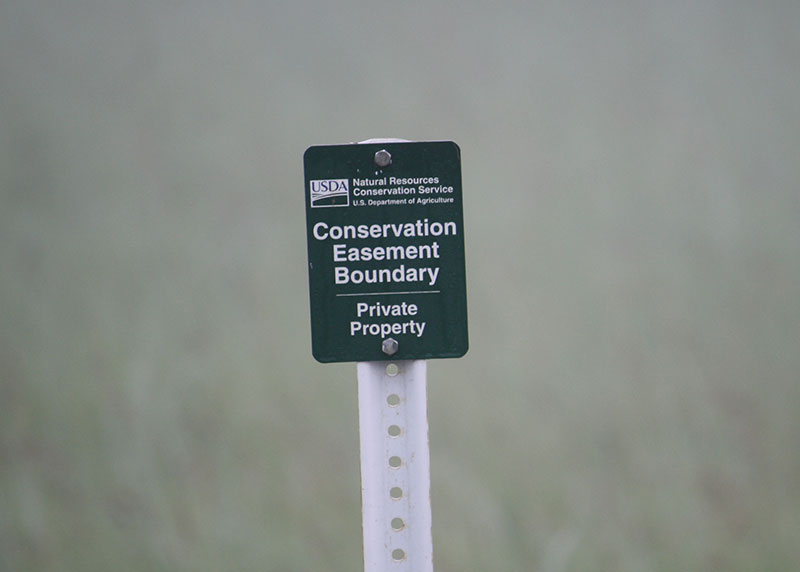
Throughout the Northern Great Plains, most of the land is in private ownership. As a result, partnerships between state and federal agencies and private landowners are essential for ensuring the future of wildlife. These partnerships must not only be based upon sound science-based habitat management, but also include careful consideration of a wide array of social values held by the general public and landowners.
Conservation easements and agreements are legal agreements between a private landowner and conservation organizations or government agencies. These contractual agreements restrict some land use practices of the landowner in return for direct payments by the organization, and/or in some states reduced property taxes. As a result, property owners with limited funds may potentially be able to retain the title of their land when facing increases in property taxes. Additionally, some agencies offer incentives for landowners to enroll in these easements and agreements. For example, the North Dakota Game and Fish Department offers cash incentives ($6 to $10 per acre per year (data from 2020) to landowners with new and existing 30-year USDA Wetland Reserve Program (WRP) easements in exchange for an agreement allowing public access to the property. The property can be transferred or sold, but the public access agreement is retained for the life of the WRP easement. North Dakota is the only state in the country where state law limits the life of a conservation easement to 99-years.
Although not a management practice in and of itself, the objectives of conservation easements are usually connected to specific goals of the organization or agency, such as protection of habitat types for specific species of wildlife and unique ecosystems, maintenance of riparian corridors and functioning wetlands and water quality. Federal, state and nongovernment organizations can provide technical and financial assistance for a variety of wetland and grassland habitat restoration practices including wetland restoration, wetland enhancement, upland restoration and upland enhancements such as cross fencing, water developments, riparian area pastures and wildlife friendly fences.
State private lands habitat programs are intended to compliment U.S. Department of Agriculture (USDA) conservation programs, such as the Conservation Reserve Program (CRP), Agriculture Conservation Easement Program (ACEP), Environmental Quality Incentives Program (EQIP) and the Conservation Stewardship Program (CSP). Finally, Non-Governmental Organizations (NGOs), (i.e., Delta Waterfowl, Ducks Unlimited, Pheasants Forever, National Wild Turkey Federation, Rocky Mountain Elk Foundation, Mule Deer Foundation and sportsmen’s clubs) will not only partner with state and federal agencies to support habitat enhancement, but provide volunteer labor to implement these projects. For contact information about conservation, easements and other private land partnerships, see Appendix A
Control of Invasive Plants

Leafy spurge beetles on invasive leafy spurge plants
Nonnative invasive plants and noxious weeds can dominate large portions of pastures and can reduce forage production for cattle. Additionally, many nonnative invasive plants do not provide suitable cover, structure and food for wildlife species.
Examples of nonnative invasive species that should be controlled on the Northern Great Plains include saltcedar, leafy spurge, European and Oriental bittersweet, spotted knapweed, purple loosestrife and houndstongue. Controlling invasive and noxious weeds may present challenges when promoting forbs and planting field borders and buffer strips.
Regulations regarding noxious weeds and invasive species can vary from county-to-county. Contact your county weed board for clarification about local regulations.
Field Borders and Buffer Strips
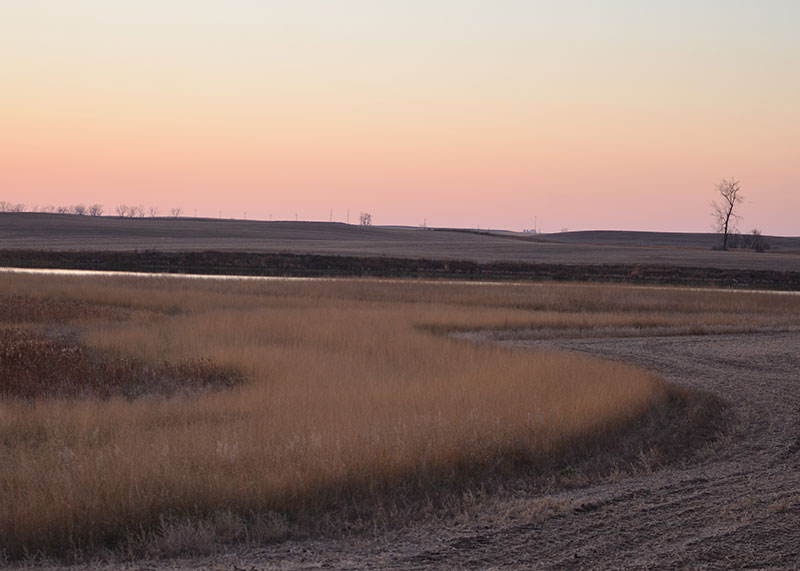
Buffer strip
Field borders are rested lands composed of uncropped grasses, forbs and shrubs around crops and hayfields. Buffer strips usually follow the edges of streams and wetlands. These areas can provide nesting, bedding and escape cover for a wide variety of wildlife. Additionally, field borders and buffer strips can prevent soil erosion and the spread of insect pests. These borders and strips should be a minimum of 30 feet for water quality purposes, but wider strips are even better for wildlife and pollinators.
For more information regarding field borders and buffer strips, contact your local NRCS agent.
Inside-out Haying
By cutting hay and harvesting crops in a pattern (i.e., from the center to outer edges) that allows wildlife to escape towards resting pasture land and unhayed areas, fawns and young broods of birds are less likely to get trapped in small strips in the middle of the field. Haying stands of grass should be delayed as late into summer as possible. Many ground nesting birds are still actively nesting until August 1. At a minimum, haying should be delayed until after July 15 for nesting birds. Additionally, use of flushing bars and avoiding nighttime haying reduces the chances of injuring wildlife.
Livestock Management

Duration and intensity of livestock grazing directly influences the height, density, composition and diversity of the plants in a pasture. Native prairie evolved with large herds of bison intensively grazing an area and moving on. Short-term intensive rotational grazing followed by long periods of rest can allow cattle to mimic the impacts bison once had on the land. The distribution and movement of livestock can be manipulated with fencing, herding and water.
Riparian areas and wetlands can be sensitive to degradation by cattle. Woody draws may also be susceptible to soil compaction and mechanical damage when cattle seek shade under trees. Some species of wildlife, such as deer during fawning season, tend to avoid pastures currently occupied by cattle. By reducing the impacts of livestock on vulnerable habitats (stream banks, woody draws) with fencing, and rotating cattle amongst pastures, pastures can be managed to provide both forage for livestock and cover for wildlife.
For more information about grazing systems that support both livestock and wildlife, visit with your local state extension service and NRCS offices (Appendix A).
Cover Crops
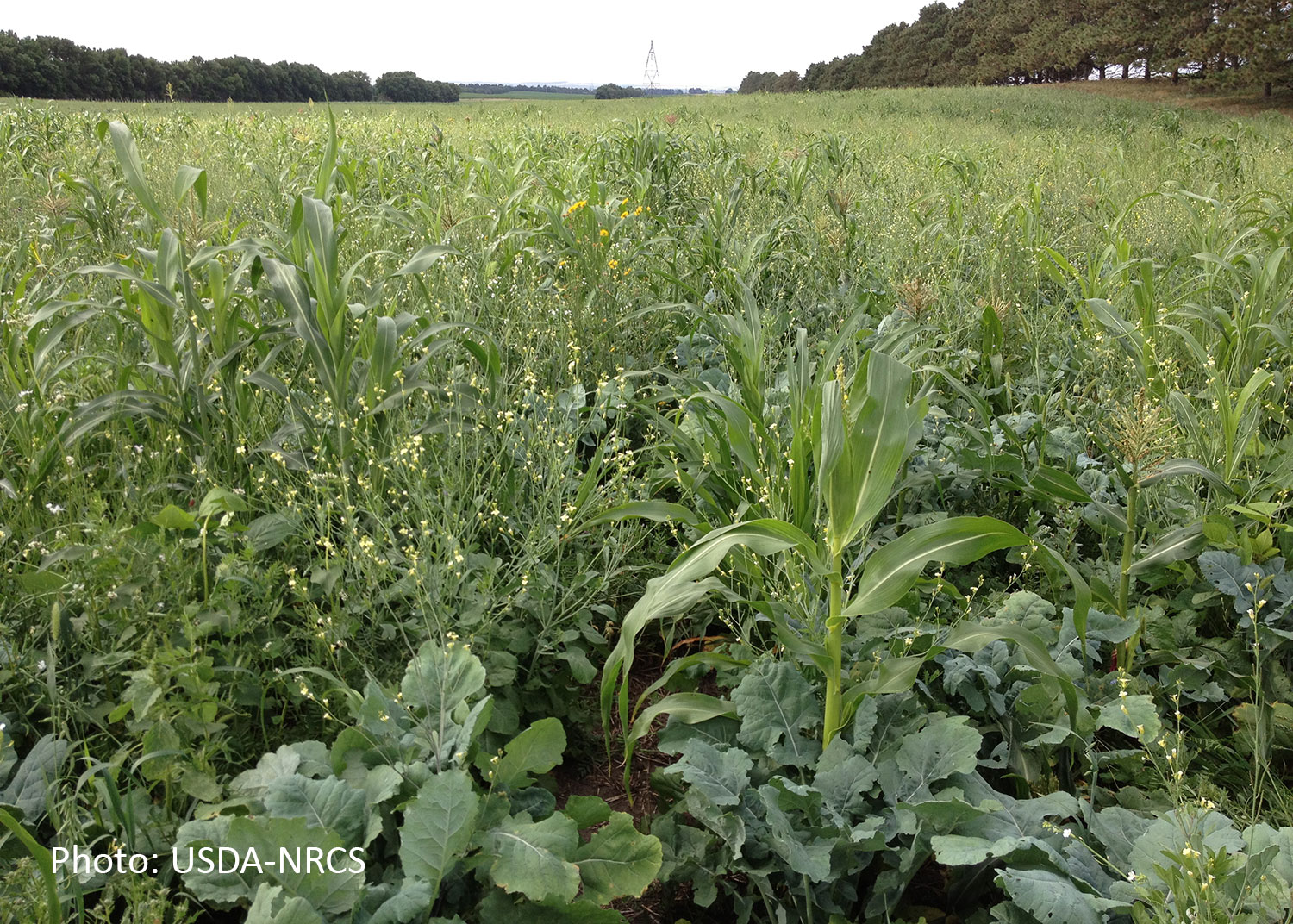
Cover crops offer several benefits to farmers and ranchers by increasing soil health, providing fall and winter forage for livestock and may reduce the need for herbicides. When cover crops are added to the crop rotation, they not only supplement forage for cattle and wildlife, they can provide secure nesting, thermal and escape cover for wildlife and food for pollinators.
This is particularly true if the cover crop is a mix of five groups of plants including:
- grasses (Sudan grass, sorghum, millet, corn),
- cereals (rye, barley, oats),
- brassicas (radish, turnips, cabbage, kale),
- chenopods (beets, spinach), and
- legumes (alfalfa, clover, field peas).
Selection of plants with an upright architecture will provide forage above the snow and optimize hiding cover. The potential benefits cover crop plantings may offer to wildlife will vary with the time of planting, seed mix and the timing of use by livestock.
Cover crop mixes need to consider chemical carry-over, soil health needs, timing and subsequent crops.
Cover crop planting regimes may include:
- Predominately cool-season annuals seeded in April and May – season long.
- Predominately warm-season annuals seeded in June and July – season long.
- Predominately cool season biennials seeded after an early harvest.
A cool-season planting that is relatively undisturbed for a growing season provides excellent nesting cover for pheasants during the late nesting season. While a cool-season mix planted in late April would provide little nesting cover for first nest attempts, it might provide adequate nesting structure later on for hens that lose their first or second nest attempts to predation or abandonment. Nesting cover is maintained by retaining a large block of grass, brood cover is enhanced by pollinator habitat, and protected wetlands maintain winter cover.
Both biennial and season-long cover crops can also provide secure brood cover if proper species are used and they are managed to maintain structure and attract insects. The key is to include multiple species of flowering plants that differ in flower color and timing of flower production. Again, insects are the primary diet of young chicks and insects are attracted to flowering plants. Insects also provide a valuable source of protein for many adult birds any time they are available, particularly for hens during nesting.
If fall or early winter food for pheasants and other birds is a concern, incorporate small grains into cover crop mixtures regardless of when the crop is planted. Species that produce a lot of seed and are of higher stature can provide valuable food well into winter, even in times of heavier snow. While most cover crops do not provide secure winter cover, sorghum-Sudan grass does have enough structure and vertical cover to protect some wintering birds from heavy snow and prolonged cold.
For more information about cover crop mixes tailored to your specific needs, visit with your local NRCS office (Appendix A). Examples of cover crop and pollinator seed mixes are provided in Appendix B.
Planting Food Plots
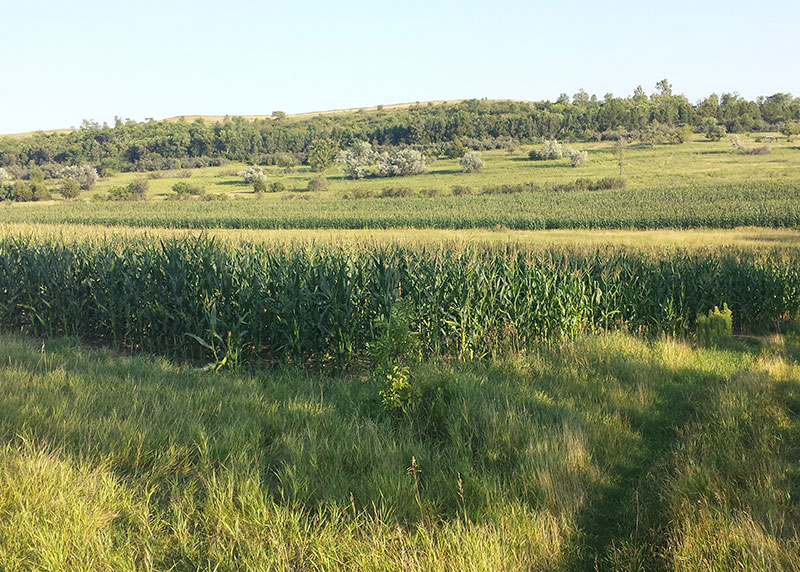
The goal of planting wildlife food plots is to provide supplemental food sources for wildlife, particularly through winter. These food plots are often planted with corn, grain sorghum, millet and sunflowers. Taller plants like corn and sunflowers tend to stand up best above the snow.
Food plots planted for deer should be of adequate size (minimum 2 to 10 acres) to provide food throughout winter. Clover, winter wheat and alfalfa food plots are heavily used by a variety of wildlife in spring and summer. Soybeans should be avoided for use in food plots, as they can cause food impaction in waterfowl.
Long (150 to 400 feet) and narrow (15 to 20 feet) food plots adjacent to escape cover tend to receive the most use by wildlife.
Placement of food plots should also be taken into consideration. For example, placement along highways may present safety concerns for both wildlife and vehicle traffic; particularly when food plots are placed on one side of a busy highway and escape cover is located on the other.
It should be noted that hunting waterfowl over mechanically manipulated food plots (e.g., disking under unharvested grains or swathed wheat) may constitute baiting and is illegal.
Find more information about the North Dakota Game and Fish food plots program here.
Leaving Crops Unharvested
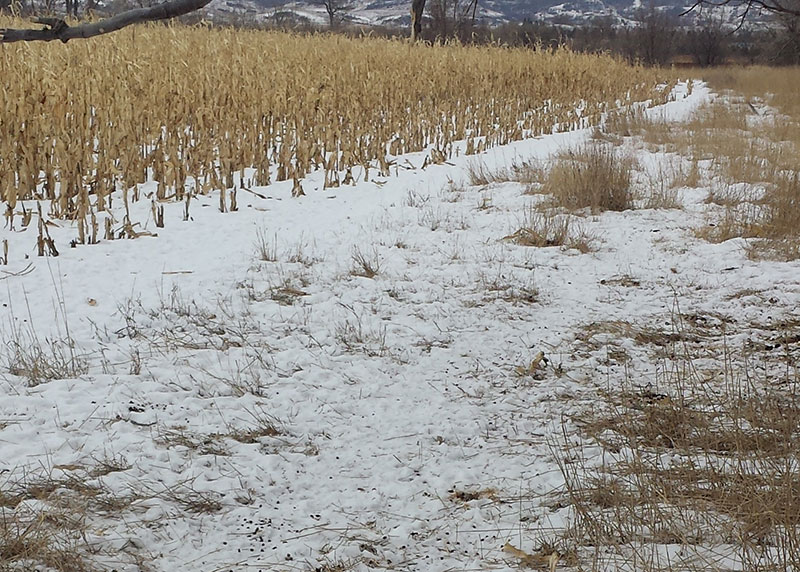
Leaving strips or small blocks of unharvested corn or grain, like established food plots, is most beneficial when adjacent to cover. However, narrow strips of unharvested crops tend to drift in with snow more rapidly in winter, limiting their availability to wildlife.
Knowing these small patches of food will not sustain wildlife, such as deer, throughout winter, it is best done in association with established food plots.
Reduced Tillage
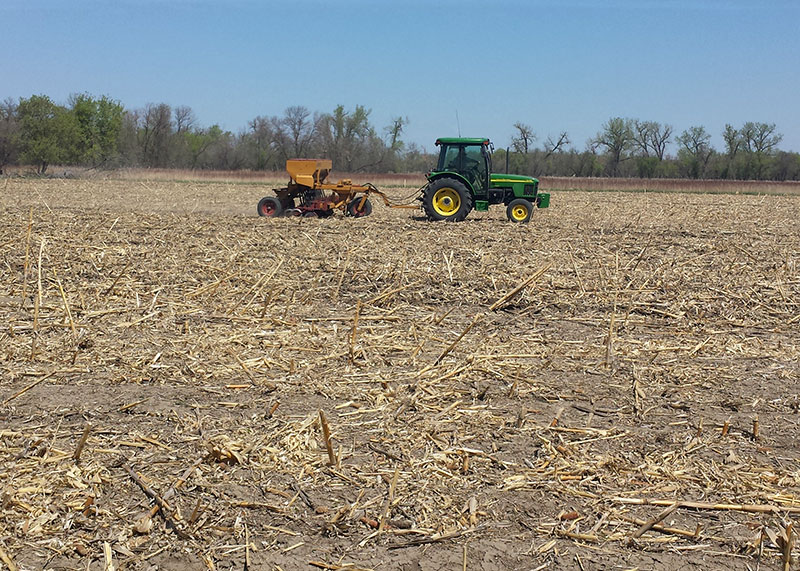
No-till is the preferred management method and can be combined with the use of cover crops.
If you do not have access to no-till drills and planters, some Pheasants Forever chapters will cooperate with landowners to cost-share the purchase of equipment.
If no-till agriculture is not possible, tilling should be delayed from fall to spring, thus allowing cattle and wildlife access to waste grain during the fall and winter months.
Also, chisel plows are preferred (over inversion or mold-board plowing), which allows more of the crop residue to remain exposed.
Harvesting small grains with a stripper header removes only the seed head, leaving standing stalks 18 to 24 inches in height. Fields harvested in this manner provide thermal and hiding cover for wildlife.
Adding winter wheat to your crop rotation can provide forage for cattle and undisturbed nesting cover for ducks and other ground nesting birds.
For more information on reduced tillage farming practices, contact your local state extension service and NRCS office (Appendix A).
Promoting Forbs

If the management desire is to invigorate planted hay land and promote forbs (broad-leaved herbaceous plants), and grazing is not an option, rake and remove litter from the soil surface.
By using a heavy harrow or other light ground disturbance after haying tame grasses, forb growth will be encouraged. Disking and harrowing should not be done on native prairie as it may induce the establishment of noxious and invasive species.
Prescribed burning of prairie in late March and April generally promotes desired warm-season grasses and forbs. Late season prescribed burns (September) will also reduce woody vegetation encroachment and encourage forb growth. Prescribed burning can be labor intensive and require special equipment. Before starting a prescribed burn contact your local fire department.
Planting Native Grasses and Forbs
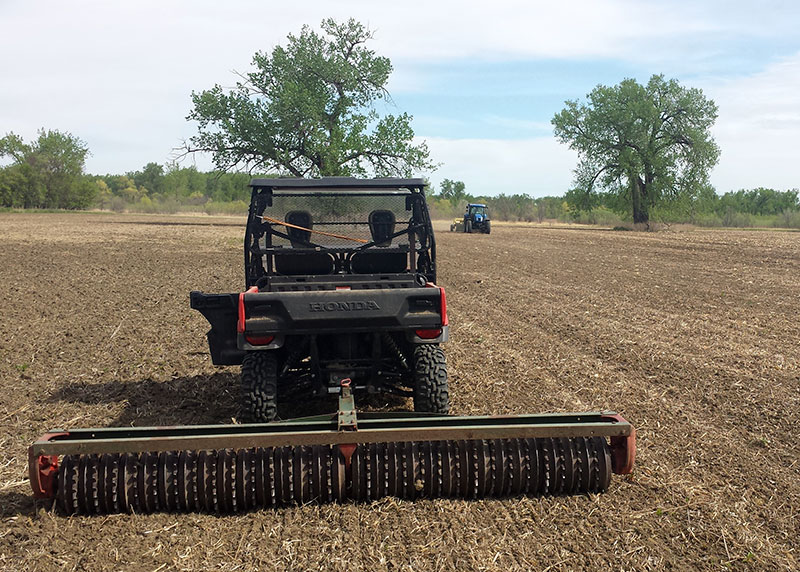
Native grasses and forbs provide nesting, bedding and escape cover for a wide variety of wildlife species. This is especially true for upland gamebirds and waterfowl that require an open, early successional cover without an overhead canopy of trees. For example, ground nesting birds often build their nests at the base of native bunch grasses like big bluestem or side-oats grama. Additionally, some species of early cool season grasses provide spring forage for deer, and many forbs provide highly nutritious forage as well as a seed source.
It is easier to maintain native prairie than try to recreate it after the land has been converted to crop production. Native prairie grasslands need to be grazed or burned on a regular basis, or undesirable exotic cool season grasses (Kentucky bluegrass, smooth bromegrass) will expand.
Providing blocks of grasslands with a minimum size of 40 acres is ideal. Planting and establishing native prairie is a multi-year commitment. It is not recommended to plant native grasses and forbs if desired native grasses and forbs are already present. Mechanical disturbance may allow nonnative invasive plants to become established.
For more information about re-establishment and maintenance of native grasses and forbs, or planting modified dense nesting cover mixes in grass stands, contact your local state extension service and NRCS office (Appendix A).
Planting Shrubs and Trees
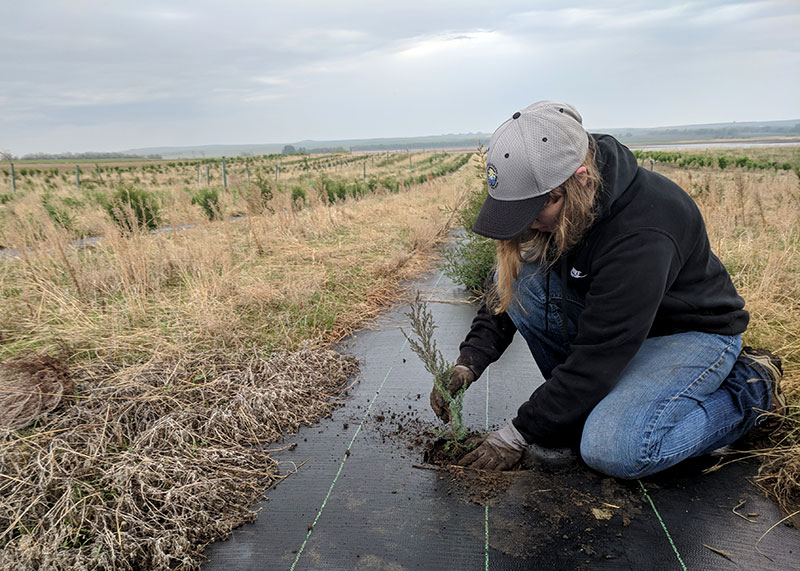
Shrubs can provide perennial cover and food for a wide variety of wildlife. In areas with large expanses of cropland, planting multi-row blocks of shrubs will provide important nesting and bedding cover.
Shrubs are generally more drought tolerant and easier to establish on the prairie compared to trees and can be easily incorporated into fencerows, field borders, riparian buffer strips and odd, irregular areas such as gullies and the corners of circular irrigation pivots.
Trees tend to require more effort to become established on the prairie; requiring tilling or weed barrier fabric, watering, and protection from over-browsing by deer. Planting trees along riparian corridors tends to be more successful in the long term once the roots have reached the water table. Narrow tree planting (one to three rows) tend to fill in with snow in the winter. We suggest that tree plantings intended to provide winter thermal cover should be 8 to 16 row shelterbelts and/or block plantings.
It should be noted that planting trees in some areas might not be appropriate. Prairie chickens, and many other grassland nesting birds, avoid areas with trees. Upland game and waterfowl biologists will discourage the planting of trees that grow tall within 300 feet of a wetland, as these trees may provide hunting platforms for hawks and owls.
Areas that have soils with high salt concentrations can be improved for wildlife by planting shrubs and trees that are tolerant of saline soils such as buffaloberry, hawthorn and skunk brush sumac.
Planting trees within native prairie grasslands has a negative impact on many grassland nesting birds; this practice is not encouraged.
By planting shrub and tree species in multi-row (five or more rows preferred) in blocks or patches (i.e., 100 feet of buffaloberry, 100 feet of conifers, 100 feet of chokecherry, etc.), the habitat edge effect is increased and may reduce the hunting efficiency of predators like red foxes and coyotes.
Conservation stock trees and shrubs can be ordered in the fall from NRCS. For more information on planting shrubs and trees, contact your local extension service or the North Dakota Forest Service (Appendix A).
Forest Management
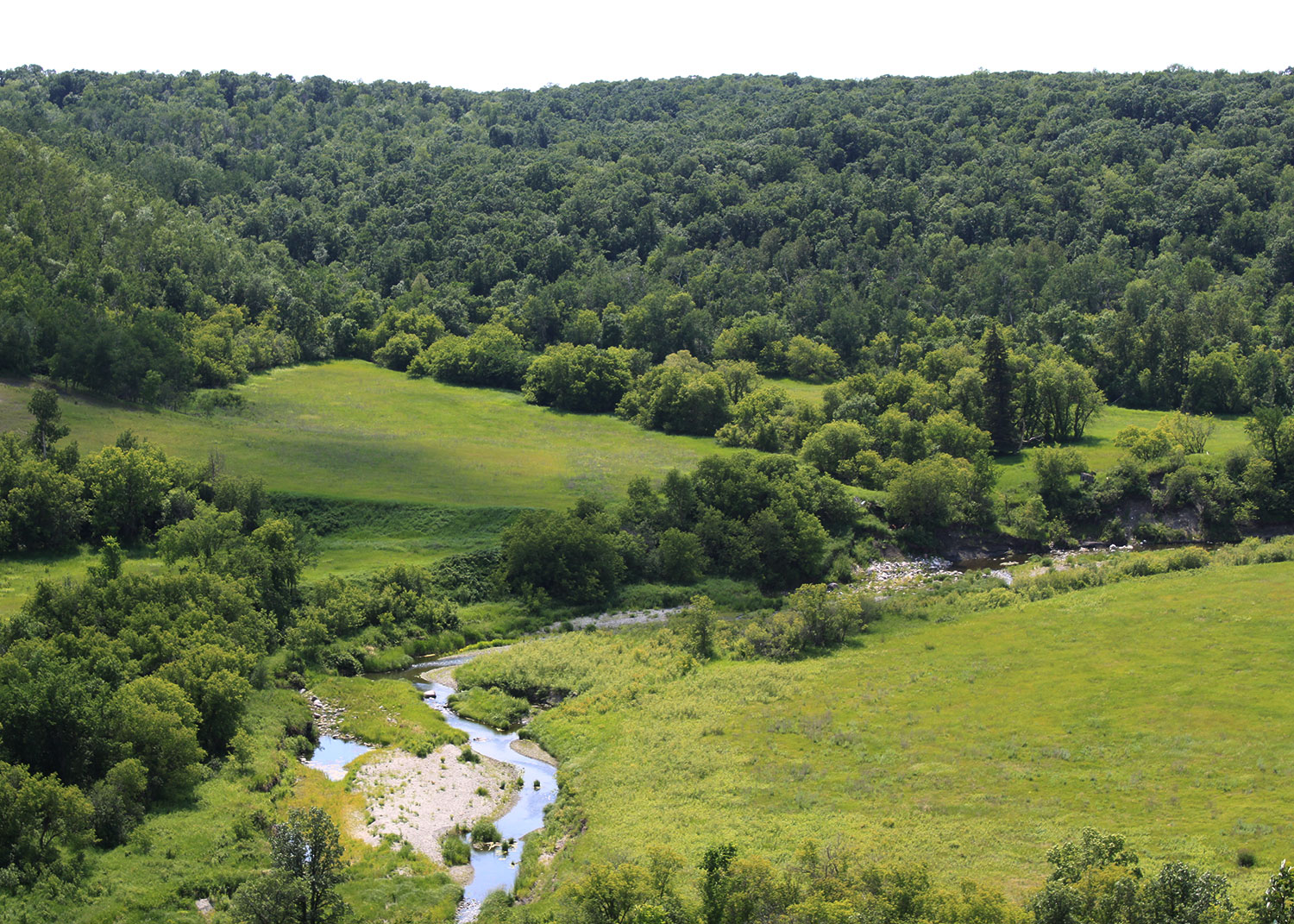
Pembina Gorge
The Northern Great Plains is one of the least forested regions in the country. That said, upland forests associated with large buttes and escarpments, riparian forests along streams and rivers, and western conifer stands are unique habitat types on the prairie. These woodlands provide important winter browse for deer and roosting trees for turkeys. Bur oaks provide highly nutritious acorn mast for a wide variety of species. Even large dead trees can provide important habitat for cavity nesting birds. Planted shelterbelts and tree rows can also serve many of these wildlife needs.
Unlike other regions of the country, management of timber production is often not economically practical; however, maintenance of trees on the prairie primarily serves to protect from soil erosion by providing a buffer from wind, providing shade and aesthetic beauty.Restricting cattle use of these areas is often needed to reduce damage to regenerating seedlings and saplings in the understory. Fencing cattle out of forested areas and farmsteads will maximize the potential of these areas being used for wildlife.
Goals and objectives of private landowners for forest management can be highly variable. For more information on best management practices for forests on the Northern Great Plains contact your local NRCS and North Dakota Forest Service offices (Appendix A).
Edge Feathering
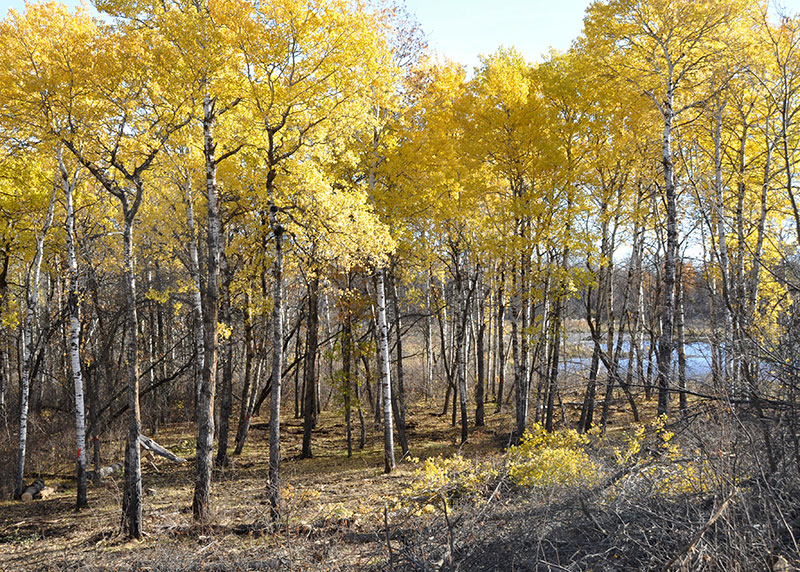
Edge feathering involves reducing the number of trees along the edge of a field so that more sunlight can enter under the forest canopy and stimulate growth of understory vegetation. This management tool may have limited application for the Northern Great Plains and is restricted to forested areas such as the Pembina Hills and Turtle Mountains. For more information regarding edge feathering and forest management, contact your local North Dakota Forest Service office (Appendix A).
Prescribed burning
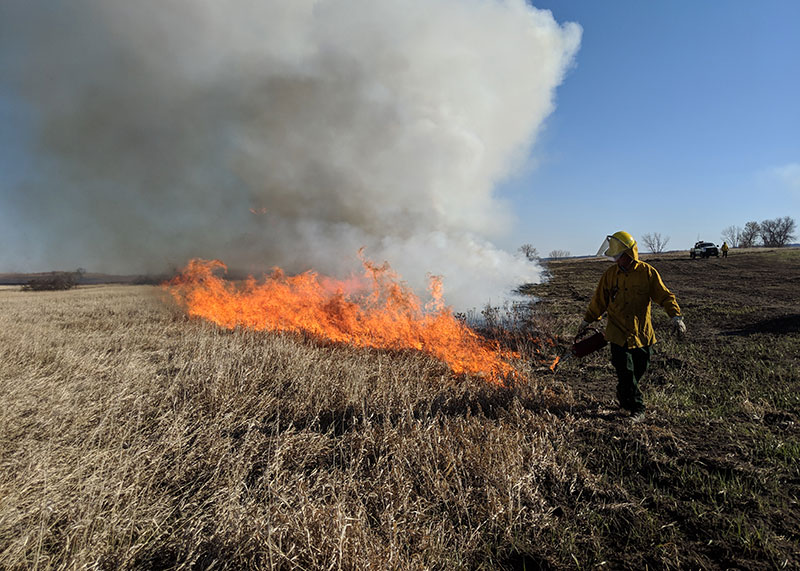
Like grazing, prairie grasslands evolved with fire, and prescribed burning is often the most effective and cost-efficient method of managing for an early successional plant community.
Prescribed burns in late summer and early fall tend to reduce woody vegetation more than spring fires.
If possible, prescribed burning should not be conducted during the primary nesting and fawning period (April 15 to August 1).
Frequency of fire also influences plant community composition. Low intensity fires every other year generally result in annual and perennial grasses and forbs. Less frequent, low-intensity fires also allow trees and shrubs to become established or dominate.
In addition to changing the plant community, burning removes dead grass and leaf litter. This, in turn, enables the seedbank in the soil to germinate, releases nutrients into the soil, and reduces fuel loads and the potential for intensive wildlife fires.
Prescribed burns need to be well planned, professionally supervised and conducted only after notification of local fire departments. Burning should not be conducted when temperatures are high and combined with low humidity and high winds. These conditions raise the potential for a fire to get out of control.
Prescribed burning can be labor intensive and require special equipment. Before starting a prescribed burn contact your local fire department.
Mechanical Manipulation
Mechanical manipulation of vegetation can include disking or dragging a harrow over a hayfield, mowing with a brush-cutter, uprooting trees and shrubs, or clearcutting a woodlot.
Use of mechanical manipulation vegetation should not be conducted during the primary nesting and fawning period (April 15 to August 1).
Disking and harrowing are not recommended for native prairie or for controlling invasive species. Instead, they are primarily used to maintain and promote annual forbs and setting back perennial grasses and woody species.
Mowed or disked strips should be about 6- to 12-feet wide and about 12- to 24-feet apart. A rule of thumb is to mow one-third of an area and leave two-thirds in an undisturbed state. These strips do not need to be mowed in straight lines, rather follow the contour of the land to reduce the potential for soil erosion.
Notes about Big Sagebrush Communities

Big sagebrush communities on the Northern Great Plains are becoming increasingly limited in their distribution. In North Dakota, big sagebrush communities are primarily restricted to the far southwestern corner of the state.
Several threatened and endangered species of wildlife are highly dependent upon the health of this grassland community.
Working towards removing and setting these areas back to early successional grassland is a mistake for both cattle and wildlife management. Any use of fire, mechanical manipulation and herbicide use will degrade or eliminate big sagebrush communities.
Special consideration and caution should be given to this unique grassland community.
Water Management and Control Structures
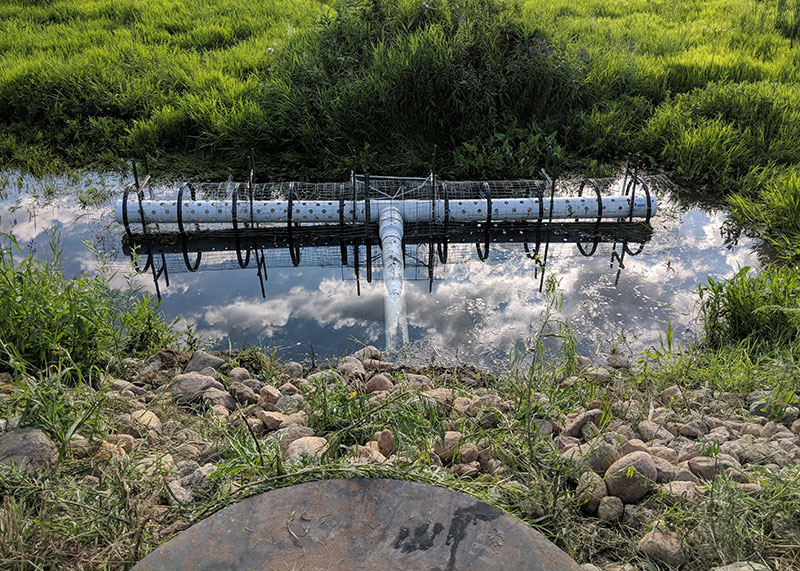
Clemson Beaver Pond Leveler
Providing a source of water is critical to livestock management as well as ducks and several other species of wildlife.
While turkeys and pheasants can often get enough water from morning dew, other species such as lactating white-tailed deer need a source of surface water within their home range.
Cattail management for ducks involves working towards maintaining a patchwork of open water and emergent plants at a desired 50/50 ratio. Cattail stands can also provide important thermal cover during winter for pheasants and deer.
Water control structures allow a landowner to control water levels within impoundments by adding or removing wood or metal planks in front of the outlet. These outlet structures are usually built into the dam or dike that impounds the water. These structures also aid in controlling flooding when beavers are frequently damming culverts.
Another tool used for controlling beaver flooding is a Clemson Beaver Pond Leveler. Shallow impoundments may be created by constructing earthen dikes to retain run-off.
Building water impoundments can have legal implications with neighbors and local government jurisdictions.
If you are interested in restoring a wetland, or developing an impoundment that would benefit waterfowl, contact the USFWS Partners for Fish and Wildlife program. They might be able to assist you with engineering, construction and cost-sharing for the project (Appendix A).
Preventing Disease and Depredation Problems
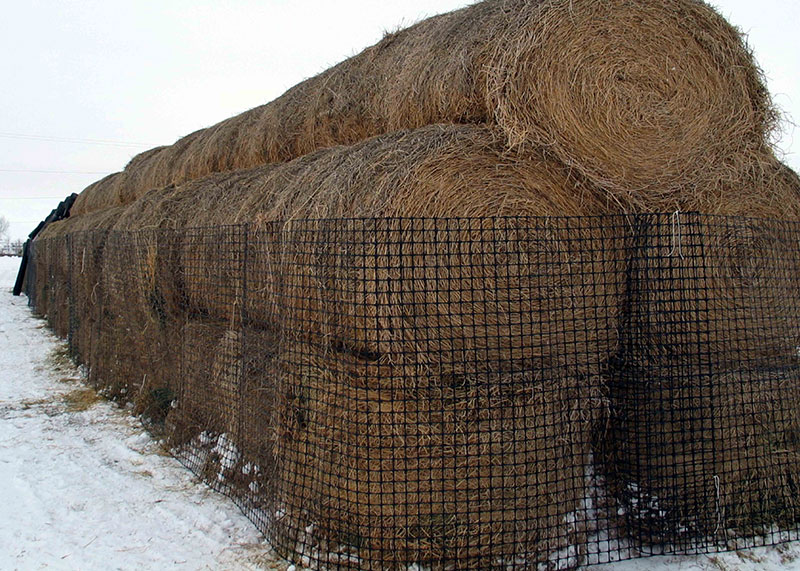
Artificial feeding programs, such as feeders, bait stations and grain piles may increase disease transmission and lead to deaths from grain overloading in deer.
Artificially increasing deer density can lead to a larger depredation problem.
Hay bales should not be left in the field. Stack hay and place grain bags in an accessible area where water will not collect, and they can be fenced and monitored. Put alfalfa and the most high-quality hay in the center and on top of the stack.
Silage pits should be fenced off and gated.
More information on preventing wildlife depredation problems can be found here.

